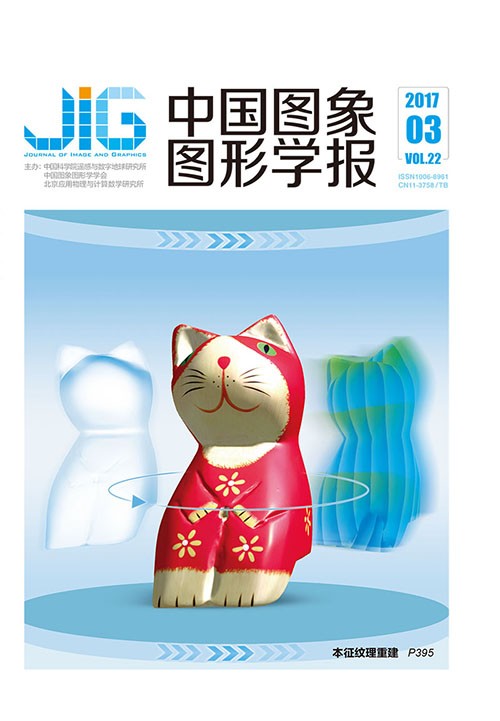
渲染器与Web服务器耦合实现远程体 渲染的交互优化
摘 要
目的 为使用户随时随地获得需要较大计算和存储资源的交互真实感体渲染服务,设计并实现了一种面向Web的远程真实感体渲染方法。方法 计算量较大的实时体渲染任务由远端渲染服务器中的GPU加速完成并通过WebSocket将渲染图像发送至客户端;客户端浏览器只需负责接收显示渲染图像并监听发送用户交互事件。提出了一种输出系统耦合算法用以连接输出图像速率较大的渲染服务器和发送图像速率较慢的Web服务器。算法能根据Web服务器发送图像的情况动态调整每次图像输出的迭代计算次数,改变渲染服务器输出图像的时间间隔以达到与Web服务器发送速度相平衡,同时保持渲染服务器持续工作。结果 实验比较了在不同网络传输条件下,采用输出系统耦合算法与直接连接渲染器和Web服务器,渲染4个不同数据集所需的完成时间及帧率等性能评价指标。在局域网和广域网环境下,本文方法分别最多只需17 s和14 s即可完成整个渲染过程,而采用直接连接渲染器和Web服务器的方法则分别至少需要31 s和60 s才能完成整个渲染过程。实验结果表明采用输出系统耦合算法在不同网络条件下均可较大地缩短整个渲染过程所需时间,使用户在较短时间内获得高质量渲染图像。结论 本文渲染器与Web服务器耦合实现远程体渲染交互优化的方法可让用户使用与计算能力无关的桌面或移动设备通过网络透明使用高性能渲染系统;系统采用的输出系统耦合算法能够根据网络承载能力自适应调整渲染器输出速度,使用户在不同的网络环境中均可以较快的速度获得高质量渲染图像。
关键词
Optimized interactive remote realistic volume rendering using renderer server and Web server coupling algorithm
Gao Zhan1, Sun Wanjie2, Wang Jiehua1, Jiang Zhengzheng1(1.School of Computer Science and Technology, Nantong University, Nantong 226019, China;2.School of Electronic Information, Nantong University, Nantong 226019, China) Abstract
Objective Modern medical imaging devices, such as CT and MRI, can provide detailed data representations of the interior of the human body. Realistic volume rendering incorporates Monte Carlo path-tracing algorithm, which addresses the visualization of these data to provide photorealistic images. However, Monte Carlo path-tracing volume rendering demands high storage volume and computational power. Therefore, it can only be interactively visualized on clusters with installed high-performance GPU. Current mobile devices, such as smart phones and tablets, significantly contribute to mobile computing. The realistic volume rendering of high-volume datasets at interactive update rates is still computationally expensive for current hand-held devices because of the limitations of computational capability and power consumption. Remote rendering helps address this issue by running heavy-volume rendering computation on a powerful GPU-accelerated server and transmitting the rendering results to the mobile client for display and interaction.Methods A volume renderer that utilizes Monte Carlo path-tracing (MCPT) techniques was set up to progressively generate realistic images. A dedicated web server sent rendering results to and received user inputs from mobile devices. Renderer servers can produce rendered images at a high updating rate, whereas web server streams render images at a slower rate than a renderer server, particularly when network conditions are poor. Low rendering efficiency is caused by unbalanced data transmission and processing rate between renderer servers and web servers. This paper introduced optimized coupling and performance between a graphic server and web server to improve rendering efficiency and maintain system interactivity. The coupling algorithm can balance the output speed of renderer servers and transfer speed of web servers by adaptively adjusting the rendering iterations of each output image and keeping renderer servers busy before completing rendering tasks.Results To directly compare the performance of the coupling algorithm with that of a connected volume renderer server with web server, we set up an experiment that recorded the total frames received by browsers and the duration of the entire rendering process after user interaction was terminated. The experiment utilized Manix, Mecanix, VisMale, and Bonsai volume datasets. Experimental results indicated that using the coupling algorithm between renderer servers and web servers significantly reduced the time required to achieve the final high-quality image, unlike the direct connection between renderer servers and web servers. The results also revealed that the renderer server connects with web servers via the coupling algorithm, which allows end users to obtain the final high quality image in nearly the same amount of time, regardless of network condition.Conclusion Web-based realistic remote volume rendering system is proposed to provide end users with access to high-performance rendering services using any HTML5 supported device. The coupling algorithm that links renderers and Web servers can adjust the output speed of the renderer depending on the overall capacity of a network while maintaining the performance of the renderer. Thus, end users quickly obtain the final rendered images.
Keywords
|



 中国图象图形学报 │ 京ICP备05080539号-4 │ 本系统由
中国图象图形学报 │ 京ICP备05080539号-4 │ 本系统由